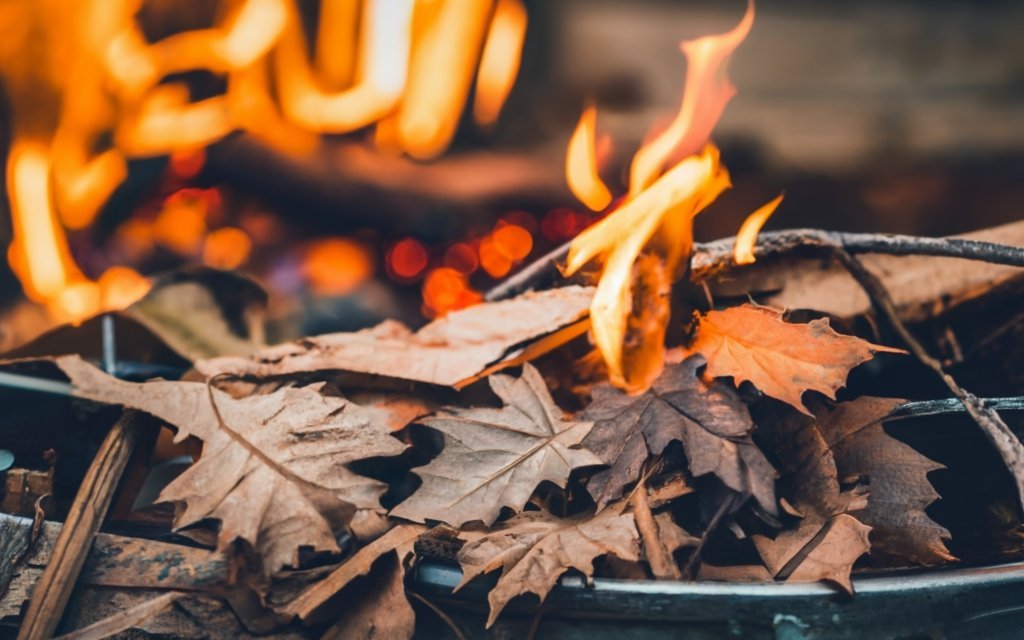Burning leaves has long been a traditional method of disposing of fallen foliage, whether it be in our backyards or during camping trips. However, as we become more aware of the negative impact it has on our environment, it’s time to rethink this practice. While it may seem harmless, there are several reasons why burning leaves in your campfire should be avoided. From air pollution to harmful effects on wildlife, here are seven reasons why you should skip burning leaves at your next campfire.
The Environmental Impacts of Burning Leaves
Burning leaves may seem like a harmless way to dispose of fallen foliage, but it actually has several detrimental environmental impacts. Firstly, burning leaves releases a significant amount of carbon dioxide, a greenhouse gas that contributes to climate change. The carbon stored in the leaves is released into the atmosphere, adding to the already high levels of carbon dioxide. This not only contributes to global warming but also disrupts the delicate balance of our ecosystem.
Additionally, burning leaves releases other harmful pollutants into the air. Particulate matter, such as ash and soot, can cause respiratory problems and contribute to air pollution. These particles can be carried by the wind and settle on plants, bodies of water, and even on buildings, causing damage and pollution. The release of volatile organic compounds (VOCs) during burning can also lead to the formation of ground-level ozone, a harmful air pollutant that can cause respiratory issues.
Furthermore, burning leaves destroys the natural habitat and food sources for wildlife. Many insects, birds, and small mammals rely on leaf litter for shelter and sustenance. By burning leaves, we disrupt this balance and can cause long-term harm to local ecosystems.
The Potential Health Risks of Burning Leaves
Burning leaves may seem like a harmless activity, but it actually poses several potential health risks. When leaves are burned, they release a variety of harmful pollutants into the air, which can have detrimental effects on human health.
One of the main health risks associated with burning leaves is respiratory problems. The particulate matter, such as ash and soot that is released during burning can irritate the respiratory system and lead to breathing difficulties. This can be particularly problematic for individuals with asthma, allergies, or other respiratory conditions. Inhaling these pollutants can also cause coughing, wheezing, and shortness of breath.
Furthermore, burning leaves releases volatile organic compounds (VOCs), which can contribute to the formation of ground-level ozone. This can lead to respiratory issues, such as throat and lung irritation, and can exacerbate existing respiratory conditions. Inhaling ground-level ozone can also reduce lung function and increase the risk of respiratory infections.

Another potential health risk of burning leaves is the release of carbon monoxide. Carbon monoxide is a colorless and odorless gas that can be extremely dangerous if inhaled in high concentrations. It can cause headaches, dizziness, nausea, and, in severe cases, can lead to unconsciousness or even death. Therefore, it is important to be mindful of the dangers of carbon monoxide poisoning when burning leaves.
In addition to these respiratory and carbon monoxide risks, burning leaves can also contribute to allergies. The smoke and particles released during burning can contain allergens, such as pollen, mold spores, and other irritants. These can trigger allergic reactions in susceptible individuals, causing symptoms like sneezing, itching, and watery eyes.
Overall, burning leaves pose potential health risks that should not be taken lightly. It is important to find alternative methods for disposing of fallen foliage to protect both our environment and our well-being.
Detrimental Effects on Air Quality and Visibility
Burning leaves may seem like a harmless activity, but its detrimental effects on air quality and visibility should not be overlooked. When leaves are burned, they release a plethora of pollutants into the atmosphere, leading to decreased air quality and reduced visibility.
One of the main contributors to the negative effects on air quality is the release of particulate matter. Ash and soot, which are released during burning, can be carried by the wind and dispersed over large areas. These particles can cause respiratory problems and contribute to air pollution. Not only do they pose a risk to human health, but they can also settle on plants, bodies of water, and even buildings, causing damage and pollution.
Additionally, the release of volatile organic compounds (VOCs) during burning can further deteriorate air quality. VOCs can react with other pollutants in the atmosphere and form ground-level ozone, a harmful air pollutant. Ground-level ozone can irritate the respiratory system and cause respiratory issues, such as throat and lung irritation.
In terms of visibility, the smoke produced by burning leaves can significantly reduce visibility in the surrounding areas. The particles and pollutants in the smoke can scatter and absorb light, creating a hazy or smoggy appearance. This can make it difficult to see objects or landmarks, potentially causing safety hazards, especially during camping trips or in densely populated areas.
Overall, burning leaves has detrimental effects on air quality and visibility, compromising both human health and the environment. It is crucial to find alternative methods for leaf disposal to mitigate these negative impacts and preserve the quality of our air and visibility.
Legal Consequences and Restrictions
While burning leaves in your campfire may seem like a harmless activity, it is important to be aware of the legal consequences and restrictions surrounding this practice. Many regions have implemented laws and regulations that prohibit or restrict the burning of leaves due to the environmental and health risks associated with it.
In some areas, burning leaves is strictly prohibited, and individuals who are found burning leaves may face fines or other legal penalties. These regulations are in place to protect the environment and the health of individuals in the community. The release of pollutants during the burning process can not only harm the environment but can also have detrimental effects on air quality and human health.
Even in areas where burning leaves is not completely banned, there may be restrictions on when and where it is allowed. This is to prevent the spread of fires and minimize the impact on air quality. It is important to check with local authorities or fire departments to ensure compliance with any restrictions or regulations that may be in place.
Instead of burning leaves, there are alternative methods for leaf disposal that are both safe and environmentally friendly. Composting, mulching, or utilizing leaf collection programs provided by local municipalities are all viable options for managing fallen foliage.
By adhering to legal regulations and finding alternative methods for leaf disposal, we can protect the environment, preserve air quality, and ensure the safety and well-being of ourselves and our communities. It is important to be mindful of the potential consequences and restrictions surrounding burning leaves and to make responsible choices when it comes to managing fallen foliage.
1. Creates a Fire Hazard
Burning leaves may seem like a harmless activity, but it actually poses a significant fire hazard. Dry leaves can easily catch fire and spread rapidly, especially in dry and windy conditions. This can lead to uncontrolled wildfires, endangering both natural landscapes and human communities.
When leaves are burned, the fire can quickly get out of control and spread to nearby vegetation, trees, and even buildings. This puts lives and property at risk, and the consequences can be devastating. Uncontrolled wildfires have the potential to destroy entire ecosystems, displace wildlife, and cause irreparable damage to the environment.
Additionally, burning leaves in your campfire can create sparks and embers that the wind can carry and start new fires in unintended areas. This can lead to a chain reaction, where multiple fires are ignited and spread rapidly, making it difficult for firefighters to contain and extinguish them.
Even if you are careful and take precautions when burning leaves, accidents can still happen. All it takes is one moment of negligence or a sudden change in weather conditions to turn a controlled burn into a dangerous fire situation.

To avoid the risk of creating a fire hazard, it is best to find alternative methods for disposing of fallen leaves. Composting, mulching, or utilizing leaf collection programs provided by local municipalities are all safe and effective ways to manage leaf litter without the danger of starting a fire.
By avoiding the practice of burning leaves, we can minimize the risk of wildfires and protect both our environment and our communities. It’s important to prioritize safety and be responsible stewards of our natural surroundings.
2. Contributes to Air Pollution
Burning leaves may seem like a harmless activity, but it actually has a significant impact on air pollution. When leaves are burned, they release a variety of pollutants into the atmosphere, contributing to the degradation of air quality.
One of the main pollutants released during burning is particulate matter. This includes ash and soot, which can be carried by the wind and dispersed over large areas. These particles can cause respiratory problems and contribute to air pollution. Not only do they pose a risk to human health, but they can also settle on plants, bodies of water, and even buildings, causing damage and pollution.
In addition to particulate matter, burning leaves also release volatile organic compounds (VOCs) into the air. VOCs can react with other pollutants in the atmosphere and contribute to the formation of ground-level ozone, a harmful air pollutant. Ground-level ozone can irritate the respiratory system and cause respiratory issues, such as throat and lung irritation.
Moreover, the release of carbon dioxide during burning contributes to greenhouse gas emissions, which further exacerbate climate change. As carbon dioxide levels increase, the Earth’s temperature rises, leading to a variety of environmental issues.
By avoiding the practice of burning leaves, we can reduce air pollution and help protect the quality of the air we breathe. Instead, consider alternative methods for leaf disposal, such as composting, mulching, or utilizing leaf collection programs provided by local municipalities. These methods not only help reduce air pollution but also provide valuable nutrients to the soil, promoting a healthier and more sustainable environment.
3. Causes Allergies
Burning leaves may seem like a harmless activity, but it can actually contribute to allergies and trigger allergic reactions in susceptible individuals. When leaves are burned, the smoke and particles released into the air can contain allergens such as pollen, mold spores, and other irritants. These allergens can then be inhaled by individuals with allergies, leading to a variety of uncomfortable symptoms.
For those who suffer from seasonal allergies, burning leaves can exacerbate their symptoms and make them feel even worse. The smoke and particles released during burning can irritate the nasal passages, throat, and lungs, causing sneezing, itching, congestion, and watery eyes. It can make outdoor activities during the fall, like camping or hiking, extremely uncomfortable for individuals with allergies.
In addition to seasonal allergies, burning leaves can also trigger allergies in individuals who are allergic to specific types of trees or plants. Different types of leaves produce different allergens, and when burned, these allergens can be released into the air and cause allergic reactions. This can be particularly problematic for individuals with severe allergies, as even a small amount of exposure to these allergens can lead to severe symptoms.
To avoid triggering allergies, it is best to find alternative methods for leaf disposal. Composting, mulching, or utilizing leaf collection programs provided by local municipalities are all viable options that can help manage fallen foliage without causing allergic reactions. By opting for these alternatives, individuals with allergies can enjoy the beauty of fall without suffering from uncomfortable symptoms.
4. Contributes to Lung Damage
Burning leaves may seem like a harmless activity, but it can actually have detrimental effects on lung health. When leaves are burned, they release a variety of pollutants into the air that can be harmful to the respiratory system.
One of the main pollutants released during burning is particulate matter. This includes ash and soot, which can irritate the lungs and lead to respiratory issues. Inhaling these particles can cause inflammation in the airways, making it difficult to breathe. For individuals with pre-existing respiratory conditions, such as asthma or chronic obstructive pulmonary disease (COPD), the effects can be even more severe. It can trigger asthma attacks and exacerbate symptoms, leading to increased reliance on medication and a decreased quality of life.
In addition to particulate matter, burning leaves also release volatile organic compounds (VOCs) into the air. These compounds can irritate the respiratory system and cause lung damage over time. Prolonged exposure to VOCs can increase the risk of developing respiratory diseases, such as bronchitis or pneumonia.
Children, older people, and individuals with compromised immune systems are particularly vulnerable to the harmful effects of burning leaves on lung health. Their respiratory systems may not be able to handle the pollutants released during burning as effectively, putting them at a higher risk of developing respiratory issues.
To protect your lung health and the lung health of those around you, it is important to find alternative methods for leaf disposal. Composting, mulching, or utilizing leaf collection programs provided by local municipalities are all safe and effective options. By avoiding the practice of burning leaves, we can reduce the risk of lung damage and ensure that our respiratory systems stay healthy and strong.
5. Increases the Risk of Heart Disease
Burning leaves may seem like a harmless activity, but it can actually increase the risk of heart disease. When leaves are burned, they release a variety of pollutants into the air, which can have detrimental effects on cardiovascular health.
One of the main contributors to the increased risk of heart disease is the release of particulate matter during burning. These tiny particles, such as ash and soot, can be inhaled and enter the bloodstream, triggering inflammation and oxidative stress. Over time, this can damage the lining of the blood vessels, leading to the development of atherosclerosis or the hardening and narrowing of the arteries. Atherosclerosis is a major risk factor for heart disease, as it restricts blood flow and can eventually lead to heart attacks and strokes.
In addition to particulate matter, burning leaves also release volatile organic compounds (VOCs) into the air, which can further contribute to cardiovascular problems. VOCs can react with other pollutants in the atmosphere and form ground-level ozone, which is a known risk factor for heart disease. Exposure to ground-level ozone can increase blood pressure, cause inflammation in the cardiovascular system, and impair heart function.
Furthermore, the release of carbon monoxide during burning can also have harmful effects on the heart. Carbon monoxide is a poisonous gas that can bind to hemoglobin in the blood, reducing its ability to carry oxygen to the body’s tissues and organs. This can put extra strain on the heart and increase the risk of cardiovascular events.
To reduce the risk of heart disease, it is important to avoid burning leaves and find alternative methods for leaf disposal. Composting, mulching, or utilizing leaf collection programs provided by local municipalities are all safe and effective options. By making these choices, we can protect our cardiovascular health and promote a safer and cleaner environment.
6. Carbon Monoxide Poisoning
Carbon monoxide poisoning is a serious risk associated with burning leaves, and it should not be taken lightly. When leaves are burned, carbon monoxide is released, a colorless and odorless gas that can be extremely dangerous if inhaled in high concentrations. The symptoms of carbon monoxide poisoning can be subtle and easily overlooked, which makes it even more concerning.
Exposure to high levels of carbon monoxide can lead to symptoms such as headaches, dizziness, nausea, and confusion. In severe cases, it can even cause unconsciousness or death. This gas can quickly fill the air around a burning leaf fire, especially in enclosed spaces or areas with poor ventilation.
What makes carbon monoxide particularly dangerous is that it can be challenging to detect. Since it is colorless and odorless, you may not realize that you are being exposed until it’s too late. That’s why it’s crucial to be aware of the dangers and take the necessary precautions.
To minimize the risk of carbon monoxide poisoning, never burn leaves in an enclosed space, such as a tent or cabin. It is also important to ensure proper ventilation when burning leaves in an open area, as the gas can still accumulate and pose a threat.
If you experience symptoms of carbon monoxide poisoning while near a burning leaf fire, immediately move to a well-ventilated area and seek medical attention. It is always better to err on the side of caution when it comes to your safety and the safety of those around you.
Conclusion
Carbon monoxide poisoning is a severe risk associated with burning leaves, and it is important to take it seriously. By avoiding the practice of burning leaves altogether, you can eliminate this potential danger and protect your health and well-being. Instead, opt for alternative methods of leaf disposal that are safe and environmentally friendly. Your health and safety should always be the top priority, and avoiding carbon monoxide poisoning is an essential step in ensuring that.
